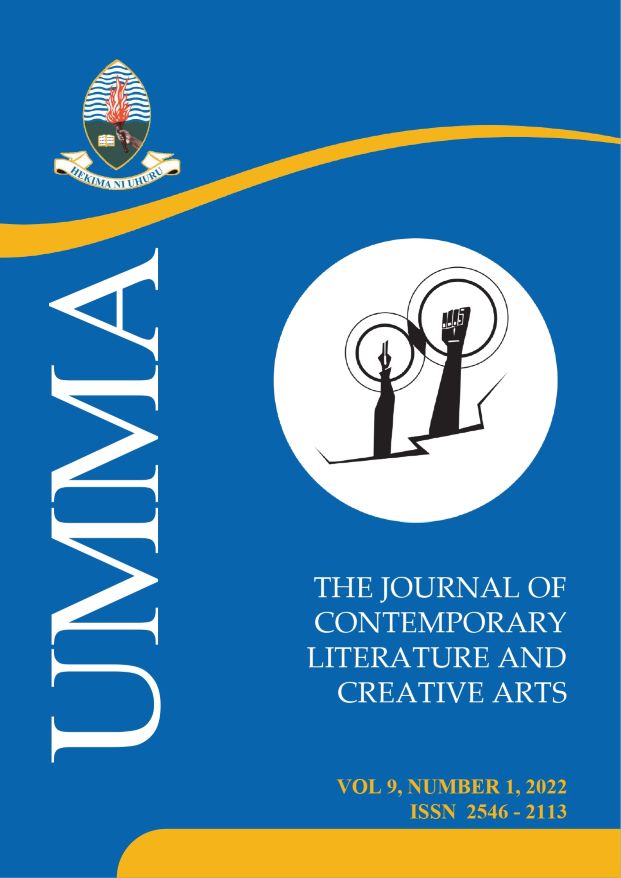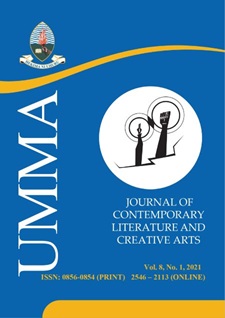Sangu Plant Tales: An Eco-portrayal of Human Floral Dependency
Abstract
Abstract Generally, plants constitute the very foundation of human and nonhuman life. These organisms, among others produce fresh air that surrounds the Earth and provide organisms with food and nutrition. They provide organisms with medication, shelter and wearable materials. Moreover, plants are vital sources and materials for botanical imagination. Their omnipresence in literature in form of tales and devices such as symbols, similes, metaphors, satire, and personification is not a new thing; they have been making their appearances in art from since time immemorial. However, a critical eye on their potential literary imaginings particularly in Tanzania ' s orality has largely been unnoticed or overlooked as a minor issue. Through the analysis of selected Sangu plant tales informed by a post-colonial eco-critical perspective, this paper shows how plant tales can help arouse general interest in plants and the floralrelated narrative experiences as resources for making sense of human dependency on the vegetal beings and as a way initiating a meaningful dialogue about environmental protection from a literary point-of-view. More significantly, the paper uses the same vegetal tales to demonstrate the credibility and richness of the environment-related genuine information, wisdom and worldviews found in the oral literature of the African people in the struggle to combat the on-going global environmental crisis. This realisation negates the long-lived misconception that African literature is mediocre and does not satisfy universal aesthetic standards and sensibilities.
Key words: Sangu people, plant tales, eco-portrayal, human dependency https://dx.doi.org/10.56279/ummaj.v9i1.5
References
References
Aghoghovwia, P. 2014, Ecocriticism and the Oil Encounter: Readings from the
Niger Delta, PhD thesis, Stellenbosch University, South Africa.
Beek, W. 2017, The transmission of Kapsiki-Higi folktales over two generations:
tales that come, tales that go, Palgrave Macmillan, Blacksburg.
Caminero-Santangelo, B. 2014, Different shades of green: African literature,
environmental justice, and political ecology, University of Virginia Press,
Virginia, VA.
Coombe, C., et al. (eds) 2020, Professionalizing your English language
teaching. Springer, Switzerland.
Ember, C., and Ember, M. 2009, Cross-Cultural Research Methods, AltaMira
Press, New York, NY.
Erdoes, R. and Alfonso, O. (eds) (1984), American Indian Myths and Legends,
Pantheon Books, New York, NY.
Finnegan, R. 2012, Oral literature in Africa, Open Book Publishers,
Cambridge.
Given, L. 2008, The SAGE encyclopaedia of qualitative research methods, 1st
ed., SAGE Publications, Inc., Los Angeles & London.
Hines, D. and Eckman, K. 1993, Indigenous multipurpose trees of
Tanzania: uses and economic benefits for people, Food and Agriculture
Organization of the United Nations (FAO) Working Paper.
Hountondji, P. 2009, Knowledge of Africa, knowledge by Africans: two
perspectives on African Studies, RCCS Annual Review, vol. 1, no. 1, pp.
-131.
Ikeke, M. 2013, The forest in African traditional thought and practice: an
ecophilosophical discourse, Open Journal of Philosophy, vol. 3, no. 2, pp.
€“50.
Jacob, L., and Jakob, N. (eds) 2019, Context in literary and cultural studies,
UCL Press, London.
Kaajan, M. 2012, The Verbal System of Sangu, a Bantu Language from South
west Tanzania, M. A. Dissertation, VU University.
Kalenge, M. 2012, Sangu Songs: A Changing Tradition, Unpublished M.A.
Thesis, University of Dar es Salaam, Tanzania.
Kangalawe, R., Mwamfupe, D. and Mbonile, M. 2007, Land management
systems and their environmental impacts in the Usangu plains, Tanzania,
Journal of the Geographical Association of Tanzania, vol. 32, pp. 15-32.
Kiyimba, A. 2001, Gender stereotypes in the folktales and proverbs of the
Baganda, Unpublished PhD Thesis, University of Dar es Salaam, Tanzania.
Mgaya, E. 2020, traditional institutions ' management of sacred forests in
Tanzania: history, narratives, and evidence from Njombe region, 1880s-2019
PhD Thesis, Victoria University of Wellington.
Mng ' ong ' o, M., Munishi, L., Blake, W., Comber, S., Hutchinson, T. and
Ndakidemi, P. 2021, Soil fertility and land sustainability in Usangu BasinTanzania, Heliyon, vol. 7, pp. 1-12.
Nanson, A. 2021, Storytelling and ecology: empathy, enchantment and
emergence in the use of oral narratives, Bloomsbury Academic, London.
Nzali, A. and Abiud, K. 2019, Prospects and challenges of village land
forest reserves management in Mbarali district, Tanzania, Open Journal of
Forestry, vol. 9, no. 2, pp. 159 €“67.
Ogungbure, A. 2013, African indigenous knowledge: scientific or
unscientific? Inkanyiso: Jnl Hum & Soc Sci, vol. 5, no. 1, pp. 12-20.
Okpewho, I. 1992, African oral literature: backgrounds, character, and
continuity, Indiana University Press, Indiana, IN.
Rugg, G. and Petre, M. 2006, A gentle guide to research methods, 1st ed.,
Open University Press, Maidenhead.
Seitel, P. 1999, The powers of genre: interpreting Haya oral literature, Oxford
Studies in Anthropological Linguistics, 22, Oxford University Press,
Oxford.
Sirima, A. 2010, Protected areas, tourism and human displacement in Tanzania:
interests and challenges behind Ruaha National Park expansion, MSc
Dissertation, Wageningen University and Research Centre.
Walia, G. 2014, The role of context in textual understanding of literature,
The Criterion an International Journal of English, vol. 5, no 1, pp. 322-329.
Walsh, M. 1995, Snakes on the Usangu plains: an introduction to Sangu
Ethnoherpetology, East Africa Natural History Bulletin, vol. 25, no. 3, pp. 38-
Zwaal, N. 2008, Narratives for nature: storytelling as a vehicle for improving the
intercultural dialogue on environmental conservation in Cameroon, VDM
Verlag Dr. Müller, Riga Latvia.
Downloads
Published
Issue
Section
License
- Authors retain copyright and grant the journal right of first publication with the work simultaneously licensed under a Creative Commons Attribution License that allows others to share the work with an acknowledgement of the work's authorship and initial publication in this journal.
- Authors are able to enter into separate, additional contractual arrangements for the non-exclusive distribution of the journal's published version of the work (e.g., post it to an institutional repository or publish it in a book), with an acknowledgement of its initial publication in this journal.
- Authors are permitted and encouraged to post their work online (e.g., in institutional repositories or on their website) prior to and during the submission process, as it can lead to productive exchanges, as well as earlier and greater citation of published work (See The Effect of Open Access).



